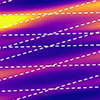| Oct 20, 2023 |
|
(Nanowerk News) Graphene is often referred to as a wonder material for its advantageous qualities. But its application in quantum computers, while promising, is stymied by the challenge of getting accurate measurements of quantum bit states with existing techniques.
|
|
Now, Tohoku University researchers have developed design guidelines that enable radio-frequency reflectometry to achieve high-speed electrical readouts of graphene nanodevices.
|
Key Takeaways
|
|
Researchers offer new design guidelines for improving the accuracy and speed of electrical readouts in graphene-based quantum devices.
The team addressed the challenge of getting precise measurements of quantum bit states in bilayer graphene by refining radio-frequency (rf) reflectometry techniques.
The researchers used a microscale graphite back-gate and an undoped silicon substrate to achieve optimal rf matching conditions, enabling more accurate and quicker electrical readouts.
The breakthrough allows for the observation of Coulomb diamonds, indicating the formation of quantum dots and opening new avenues in the study of two-dimensional materials.
The development is critical for the fast and accurate functioning of next-generation devices, especially in the context of quantum computing.
|
 |
| (a) The layer structure of the fabricated device. (b) The resonant circuit used for rf-reflectometry. (Image: Tohoku University)
|
The Research
|
|
Graphene is well-known for its high electrical conductivity, mechanical strength, and flexibility. Stacking two layers of graphene with atomic layer thickness produces bilayer graphene, which possesses excellent electrical, mechanical, and optical properties. As such, bilayer graphene has attracted significant attention and is being utilized in a host of next-generation devices, including quantum computers.
|
|
But complicating their application in quantum computing comes in the form of gaining accurate measurements of the quantum bit states. Most research has primarily used low-frequency electronics to overcome this. However, for applications that demand faster electronic measurements and insights into the rapid dynamics of electronic states, the need for quicker and more sensitive measurement tools has become evident.
|
|
Now, a group of researchers from Tohoku University have outlined improvements to radio-frequency (rf) reflectometry to achieve a high-speed readout technique. Remarkably, the breakthrough involves the use of graphene itself.
|
 |
| The dependence of rf reflection characteristics on gate voltage, showing the change in conductance. (Image: Tohoku University)
|
|
The team sfindings have been published in Physical Review Applied (“Radio-Frequency Reflectometry in Bilayer Graphene Devices Utilizing Microscale Graphite Back-Gates”).
|
|
Rf reflectometry works by sending radio frequency signals into a transmission line and then measuring the reflected signals to obtain information about samples. But in devices employing bilayer graphene, the presence of significant stray capacitance in the measurement circuit leads to rf leakage and less-than-optimal resonator properties. Whilst various techniques have been explored to mitigate this, clear device design guidelines are still awaited.
|
|
“To circumvent this common shortfall of rf reflectometry in bilayer graphene, we employed a microscale graphite back-gate and an undoped silicon substrate,” says Tomohiro Otsuka, corresponding author of the paper and associate professor at Tohoku University’s Advanced Institute for Materials Research (WPI-AIMR). “We successfully realized good rf matching conditions, calculated the readout accuracy numerically, and compared these measurements with direct current measurements to confirm its consistency. This allowed us to observe Coulomb diamonds through rf reflectometry, a phenomenon indicating the formation of quantum dots in the conduction channel, driven by potential fluctuations caused by bubbles.”
|
 |
| Coulomb diamonds originating from the formation of quantum dots are observed by monitoring the reflected voltage from the resonator. (Image: Tohoku University)
|
|
Otsuka and his team’s proposed improvements to rf reflectometry provide important contributions to the development of next-generation devices such as quantum computers, and the exploration of physical properties using two-dimensional materials, such as graphene.
|




